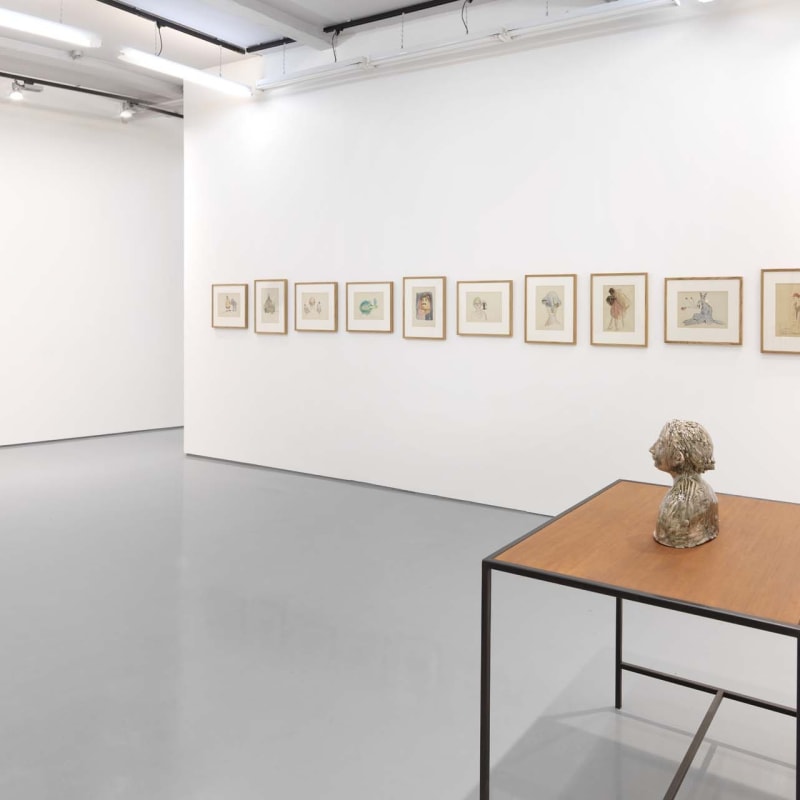Paloma Varga Weisz’s 2012 exhibition at Sadie Coles presents a series of new sculptures in glazed ceramic. Modelled by hand and finished in muted tones, the works range between emotionallycharged portraits and depictions of imaginary characters. Their fraught surfaces and halfmaterialised forms produce a sense of history entangled with the workings of imagination and memory. The objects have been variously positioned on the walls, floor and plinths in order that visitors view them from above or below or move around them, entailing a deliberate and self-conscious process of looking.
Varga Weisz’s objects speak dually of their own sturdy physicality and of subjects both real and fictional. Two large sculptures of faces, Old Father and Young Father (both 2011), suggest suspended death masks. In the first, the clay has been scored and mottled to suggest an aged face. Its counterpart is finished in silver paint – the sheen of youth – which reflects the viewer back in fractured form. Here, the act of looking is imbued with a sense of remembering or reaching into history.
Varga Weisz’s traditional medium itself enacts the idea of exhuming the past, and several works specifically evoke scenes of unearthing or conversely of burial. In em>Father (2011), an impressionistic face is embedded within a rough coil of ceramic which we are required to peer into as if into the ground. Finished in a uniform metallic glaze, the work recalls the myth of the Golem, and related Biblical and classical accounts of man begin wrought from the stuff of the earth.
Downstairs, viewers are implicated as witnesses to a passed or passing life in the sculpture Mother (2011). A figure lies on a table in a shroud, captured ambiguously in either sleep or death. As with other works in the show, the grey-green tinted figure appears to be metamorphosing, at once emerging from and receding into the slab beneath it. The scene hovers between personal and paradigmatic contexts: the sense of a remembered event combines with echoes of Mategna’s Lamentation over the Dead Christ (1480) or the sarcophagi of saints. Similarly in Kneeling (2011), a hooded figure with closed eyes, a real-life figure is suggested at the same time as a saintly character from religious art.
In line with Varga Weisz’s earlier practice, certain works conjure forth imaginary and iconographic characters. Face in a leaf (2011), a masklike head enfolded in rough layers of ceramic, again conjures an image of preternatural metamorphosis. The sculpture inclines towards abstraction, with the ghostly visage at the centre half obscured by textured mouldings in which the marks of the artist’s hands are apparent. A more mirthful note is struck by Monster (2011), in which she depicts a tragicomic creature with outstretched paws and a doleful smile, its pose comically replicating that of the crouched figure in Kneeling. Half-human and half-beast, it closely resembles one of the enigmatic characters of Varga Weisz’s watercolour paintings. Volcano, a blistering maroon hillock punctured at the top, stands in apparent contrast to the human or animal subjects of the majority of the works. Yet it serves as a powerful emblem of the understated yet brimming intensity of the entire body of work.
Paloma Varga Weisz (born 1966) lives and works in Düsseldorf, Germany. She trained at Staatliche Kunstakademie, Düsseldorf. Recent solo exhibitions include Spirits of My Flesh, Chapter, Cardiff (2011), and the Douglas Hyde Gallery, Dublin (2006). She has been included in numerous group shows including the Folkestone Triennial, UK (2011), Lust for Life and Dance of Death, Kunsthalle Krems, (2010), and the Berlin Biennale (2006). She has a major forthcoming exhibition at Museum Schloss Morsbroich, Leverkusen (2012).
For further information please contact the gallery at +44 (0)20 7493 8611 or press@sadiecoles.com
